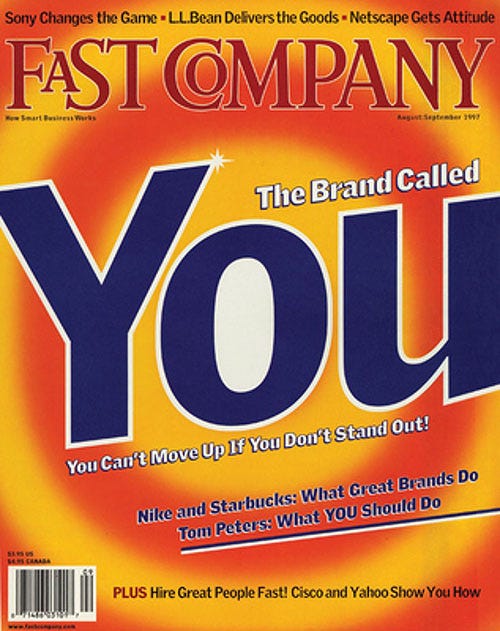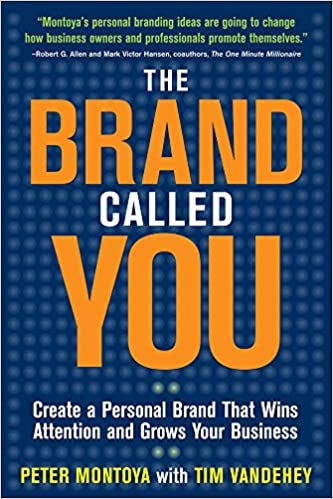“The Brand Called You” - Tom Peters, 1997; And Still Valid Today
You are what the clients want to be a part of. Are you interesting enough to make that happen?

Hi, and welcome to my little Substack corner. I write about photography, art, design, and the craft of living creatively. I am glad you are here. Consider subscribing to keep up with what I am doing. I promise not to bore you. If you would like to support my efforts, that would be amazing and so appreciated. Either way, I am super happy you are here.
YOUR PERSONAL BRAND
One of the things we frequently hear is that your personal brand is everything. I believe that to be so, but I think a lot of people get their brand mixed up with their offering (or business).
Your brand is not photography.
Your brand is you.
Everything you do and everywhere you go you are spreading and introducing people to your brand.
Let’s take an example.
You have heard me say that I am perfectly fine with you doing jobs for free or very little money when offered. I am absolutely.
And that has a little to do with the photography; Shoot More – Suck Less.
It has to do with learning the craft; every gig brings its own set of circumstances, challenges, and solutions. Learning the process of working with the types of challenges a photographer faces is undoubtedly important. Better to learn on jobs that have little impact on your income.
Access is another reason I discuss; access to people, resources, and situations you may never get a chance to do without your client making it happen can be invaluable to your fledgling portfolio. You need a portfolio more than you need a few bucks. If you do not realize that, it is gonna be a long and dusty road, partner.
However, the main reason I want you to get out there is to spread your brand. You.
“THE BRAND CALLED YOU” as the cover of Fast Company screamed off its cover in 1997. Tom Peters saw what was happening and what was about to happen and he wrote one of the most important articles of the 1990’s.
It changed everything.
“We are the CEOs of our own companies," he wrote. And we are the best ones to speak for our work.
Instead of hiding in offices, the new CEOs, he argued, need to be out and become the face of the company. (It doesn’t take too much effort to see that his ministrations came to fruition.)
When you are out in the world, with your camera and your sketchbook, and possibly a copy of a portfolio or two tucked down in the bag, you are letting others know what you do.
Initially, who you are can be more powerful than what you do. When people know you, and feel comfortable with the idea of knowing you, then what you do helps define what makes you different regarding the work that you do. Read it again.
Online, we talk about communities. I think the carry-over to the real world is completely obvious. We need to develop a community around what we do, and that takes visibility.
Too many artists lead lives of solitary confinement because they believe the lie that good work is all you need to become successful.
“When they see my portfolio, I’ll get them snagged.”
Yeah… no.
That is simply wrong.
People are drawn to interesting people. People want to be around busy and productive people. People are fascinated by people who do more than they do, or do something they find interesting beyond the mundane societal norms.
Being out in the world is a personal brand builder, and making images is one of the ways we build interest.
I would love for you to be considered THE photographer of your area.
It is so much better to be the only one than the best.
This book came out in 2008, but was not written by Tom Peters. I have it and I think it is pretty good. Get it on Kindle, no need to kill a tree for this one.
Here are three questions for you:
In what ways are you building your personal brand?
How can you expand your sphere of influence to reach more people?
What do you do that would excite other people to want to join you for dinner?
A Synopsis of the Peters article from Perplexity:
Peters argued that in the modern business world, individuals need to think of themselves as brands, similar to how companies manage their brand identities. He coined the term "personal branding" and suggested that everyone should be the CEO of their own company called "Me Inc."The main points of Peters' article include:
You are a brand: In the age of the individual, you must be your own brand to stand out in the marketplace.
Differentiate yourself: Identify your unique qualities and skills that add value to others.
Visibility is key: Make yourself known for your expertise and skills.
Learn from big brands: Apply branding strategies used by successful companies to yourself.
Be your own marketing director: Actively promote your personal brand through various channels.
Continuous improvement: Always be learning and developing your skills to enhance your brand.
Network effectively: Build and maintain strong professional relationships.
Peters emphasized that personal branding is not about self-promotion, but about understanding your unique value proposition and communicating it effectively to others. He encouraged readers to start thinking about their personal brand immediately, as it's crucial for career success in the modern workplace.
A synopsis of the book by Peter Montoya and Tim Vandehey from Perplexity:
"The Brand Called You: Make Your Business Stand Out in a Crowded Marketplace" is a guide for professionals and business owners on developing a strong personal brand. The book provides step-by-step instructions on how to create and maintain a powerful brand identity.Key points of the book include:
Personal branding principles: Montoya explains the fundamental concepts of personal branding and why it's crucial in today's business environment.
Crafting a brand message: The book teaches readers how to develop an emotionally resonant branding message that effectively communicates their unique value proposition.
Creating high-quality branding tools: Montoya provides guidance on developing various tools and materials to support and promote one's personal brand.
Attracting business: The book offers strategies for using a personal brand to attract a consistent flow of clients and business opportunities.
Stand out in the marketplace: Montoya emphasizes the importance of differentiation and provides techniques for making one's business or professional identity distinct in a crowded market.
Case studies and action plans: The book includes real-world examples and actionable plans to help readers implement personal branding strategies.
Originally self-published in 2005, the book gained international popularity, selling over 65,000 copies worldwide and reaching #3 on Japan's business bestseller list. The 2008 edition was updated to address an even larger, brand-conscious market.Montoya's work builds on the concept of personal branding introduced by Tom Peters in his 1997 Fast Company article, expanding it into a comprehensive guide for professionals and business owners looking to establish a strong, recognizable brand identity.
READY FOR A NEW WEBSITE?
I did a very successful workshop a couple of months ago on teaching photographers how to help their clients get a website up and running while adding to their own bottom line.
I have been asked if I could do one that would teach a photographer to not only build a modern and aesthetically cool website landing page, but also to learn how to maintain the SEO as well as the content.
I have not built the course yet, but these would be the takeaways:
a fully designed and ready-to-launch website for the photographer
SEO tools added and explained
maintenance issues and how to keep the site relevant
instructions on how to add additional pages easily
instructions on how to edit and change the text/images on the site
I use DIVI, so you would have to have DIVI installed as well as hosting for your domain.
The price would be $225. You would also have to have a DIVI license, domain, and host for the site running WordPress.
If this sounds interesting, let me know. I can only take 5 students, but I need to gauge the interest before I finalize the course. It will be included in the new Project 52, but I want to do it as a stand-alone as well.
When you are ready, here is how I can help you succeed.
Group Mentorship: a small group of photographers who meet to show images, work on their portfolio, and build their businesses with help from a wonderful group. Lifetime membership for one fee.
One-on-one Mentorship: You and me - working together in an intense 6-month push to get you on the way to over $30K in additional revenue. The work we lay down will help you increase and scale your business for years ahead.
And the brand new P52 one-year masterclass.
Keep reading with a 7-day free trial
Subscribe to In The Frame to keep reading this post and get 7 days of free access to the full post archives.







